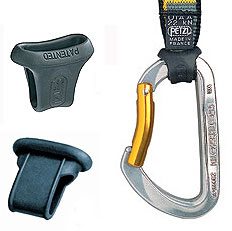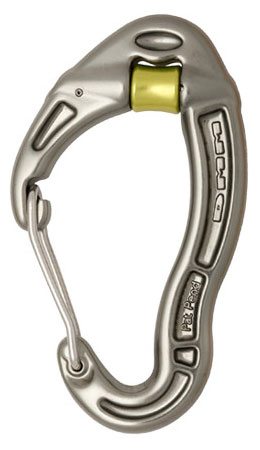Features:
- Unique pulley wheel design biner
- Strong and lightweight I-Beam construction
- Wire gate to save weight
- Shrouded nose to reduce snagging
Strength:
- Gate Closed: 24kN
- Gate Open: 9kN
- Minor Axis: 7kN
Gate opening: 24mm
Weight: 51g
MSRP: $26
The Revolver carabiner, from DMM, is an oddity in the pantheon of modern climbing gear. A sleek, wire gate carabiner with a small pulley built into the apex of the spine, the Revolver is an unlikely hybrid.
Once armed with that explanation, the “What?” of seeing one of these carabiners for the first time quickly gives way to “Why?”
Rope Drag / Friction
Reducing rope drag on a winding pitch is an obvious situation in which you might benefit from less friction between rope and draw. Indeed, DMM claims that this exact application was the inspiration of the design.
While I’ve experienced bad rope drag in my life, I also felt that it was pilot error rather than a lack of proper equipment. After all, my typical reaction to being bogged down by rope drag is to chide myself for missing an opportunity to adequately extend a key placement, etc.
Also, reducing the friction in the system isn’t always an advantage. In a situation where rope drag isn’t a problem, for example, things like shock absorption by the rope, friction through carabiners, and so on, all contribute to a reduction in the force of a fall, both on your gear and on you (i.e. by dissipating the load across many parts of the system). For this reason, even DMM notes that they don’t recommend using Revolvers exclusively, but rather that you carry one or two for routes where you anticipate particularly sharp zigs or zags.
Performance
Eldorado Canyon seemed like a good place to find some wandering pitches—it’s rife with classics that demand careful rope management. The Yellow Spur alone gives you a chance to put the Revolver to work on almost every pitch. I did find them to be helpful in reducing rope drag, especially in negotiating the traversing on the first and fourth pitches. I felt that I was able to make the most of them on the spur because I was already familiar with the climb; I knew before I left the ground where I was going to use the Revolver on each pitch. On climbs that I hadn’t been on before, I found it much more difficult to employ the Revolver to maximum effect.
The other problem I ran into came about as a result of me using the Revolver on the distal end of shoulder-length slings (since almost all drag-inducing placements should probably be extended already). Because the carabiner sits very loosely at the end of a sling, it would often flip around such that the pulley end of the carabiner held the sling rather than the rope. This, of course, completely defeats the benefit of having a pulley built into the carabiner.

You can fix this with some well-placed rubber (either a PETZL String or homemade equivalent) at the end of the sling to maintain the carabiner’s orientation. Though effective, this felt like a serious compromise, as the rubber reduced some of the versatility of an alpine draw.
It’s also important to note that the fine print of the Revolver manual states that “the integrity of the roller and bearing can be damaged at loads of 11kN or greater. This however is uncommon under normal climbing usage.” This doesn’t mean that the carabiner will fail in a catastrophic way, but simply that the roller will break. The document implies that the failure mode is due to a build-up of heat in certain loading situations.
On the whole, I can see the carabiner’s benefits in certain situations, but I wasn’t sold on the idea of carrying Revolvers around with me at all times.
The Revolver is perhaps better thought of, then, as a pulley with a carabiner built into it, rather than the other way around, which gets to the heart of how this piece of gear can be used to great benefit: rescue situations.


Nice informative review! I wonder how much of a difference carabiner profiles make in terms of friction when pulling under load. A rounded HMS carabiner would seem to reduce friction whereas a regular carabiner with a more squared off profile would add friction. On the test without the pulley-biner did you use a rounded biner or more straight edged? I guess you can have the best of both worlds with this pulley biner.